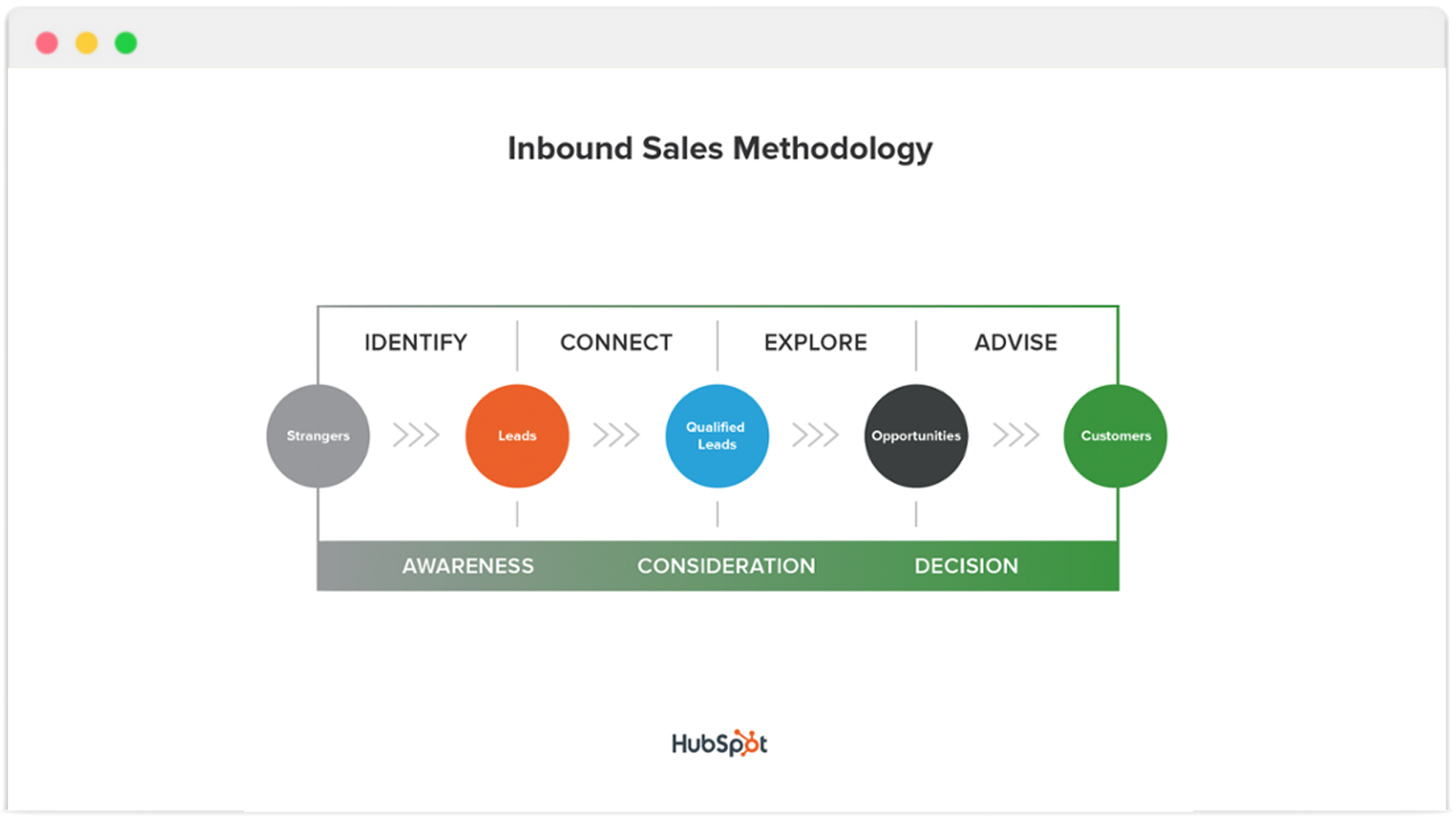What Is Inbound Sales and How Can You Benefit From It?

Inbound sales is the process that aims to constantly nurture your customers, so they can finally become your product’s ambassadors.
In this article, I’ll present you with the necessary process to achieve this goal.
A buyer’s behavior together with sales techniques and processes has evolved significantly.
Nowadays, most B2B customers decide on their purchase even before a sales rep contacts them.
Sales reps aim to assist leads in their journey. From the moment they found out about the product until they made a purchase.
However, inbound sales strategy doesn’t end here. Let’s go through the subject successively.
Table of contents:
- What is Inbound Sales?
- Inbound Sales vs Outbound Sales
- Define your buyer persona
- Align inbound sales and marketing teams
- Structure and adopt inbound sales strategy
What is Inbound Sales?
Inbound Sales is a sales methodology that prioritizes individual buyers, their needs, challenges, pain points, and goals.
Contrary to standard sales methods, here, instead of focusing on closing a sale as soon as possible, you educate, inform, nurture, and guide your lead through the decision-making process.
That’s why it’s crucial to get to know the buyer’s behavior and to analyze how he or she interacts with what we put out. This means how such a lead interacts with your website, product, service, blog posts, etc.
Thanks to such insights you’ll be able to better tailor the path that a buyer takes to become your customer.
Inbound Sales vs Outbound Sales
Inbound sales is a total opposite practice to the traditional understanding of sales management.
With the outbreak and visible success of inbound marketing, there was a need to come up with a sales approach that would better align with customers’ behavior. The main concept behind inbound vs outbound sales is their methodology.
Another distinguishing feature is that in the case of inbound sales your potential buyers come to you, while in the second – you approach them.
In outbound sales, you need to reach out to the leads educating them about your product and kind of “pushing” them to buy it. As an example, sales reps often use cold calling when trying to reach potential clients.
They usually have limited information about leads. Thus they try to promote the solution without a clear understanding if they really need it.
In the inbound sales, on the contrary, potential buyers find your service from a publication, a social media channel, etc.
They come to your well-structured website to learn how they can benefit from a service your company provides. Your task here is to arm your leads with all the necessary information. Assist them throughout an entire buyer journey. Help them to decide on their purchase.
While outbound sales look more like shouting out “buy my product now”, inbound sales focus on listening to clients and hearing out their needs rather than promising anything for the sake of a sale.
However, your sales process works the best when instead of outbound vs inbound sales, they work together.
Define your buyer persona
One of the main ideas of an inbound sales strategy is knowing who your buyer persona is.
Define your potential buyers and find out who your ideal customers are. Knowing your buyer persona will let you provide your potential buyers with all the necessary tools and information. All of this will help them make a purchase.
Previously customers were not equipped with as much information about companies and their products as they are today.
This is the reason why techniques that were used to just “sell” a product aren’t effective anymore. Instead, such approaches as listening, educating, and giving (free trials, ebooks) started to gain greater value.
There are several ways to learn your buyer persona.
First, observe how your leads and customers interact with your website.
What pages receive the most frequent visits? What content interests your potential buyers the most? Do they encounter any difficulties when browsing your website?
Clear communication, a structure that is easy to follow, useful information, and simple navigation make your website attractive. Plus, it encourages your potential buyer to learn more about your product.
Second, conduct some surveys with your current clients and check your website’s and social media analytics. Coordinate your research with the inbound marketing department to determine your buyer persona.
Once you’ve collected all the necessary information, it’s time to create your buyer persona profile. Be as specific as you can. Use the location, age, job title, interests, and the rest of the details that you’ve gathered on your potential buyer.
Third, get software that helps you in CRM (customer relationship management). While choosing the product, take care of the number of features, like having customer details before a call, two-way SMS communication, Web Call, IVR, international phone numbers, and more.
Channels have it all – get it for free now.
Channels is a data-driven phone system that covers all needs to know your buyer’s persona. It also gives additional features to make your customer service outstanding.
Right now, Channels offers you a 7-day free trial during which you’ll get full access to the software, a free phone number, and a few $$$ so you can fully test it out! No credit card is required.
What’s stopping you?
Align inbound sales and marketing teams
To better identify your buyer persona, your inbound sales and inbound marketing should be working together.
This is because your inbound sales process will be tightly connected to an inbound marketing process. In fact, its methodology was initially borrowed from the inbound marketing one.
Inbound marketing focuses on the individual buyer more rather than a wider group of people. It helps inbound sales greatly with lead generation strategies. In turn, marketing doesn’t generate revenue but sales do.
All the information that sales reps use when making a personalized call or sending a customized email comes from the efforts of inbound marketing.
This is how it works: a potential buyer fills a form on the landing page in exchange for an ebook. He engages with the company’s content such as a blog or comes from a social media campaign. Therefore, aligning both inbound sales and marketing will allow you to know your potential clients and customers even better.
Structure and adopt inbound sales strategy
As I’ve already mentioned, inbound sales aren’t about simply selling a product. Controlling every step of their buyer journey and convincing your clients that they definitely need your solution doesn’t work anymore.
Instead, adjust your sales strategy and build it around the buyer journey and their needs. Help your potential buyers at every stage.
First, let’s take a look at the inbound sales methodology, developed by Hubspot. It aligns with the inbound marketing methodology, in a similar path.

1. Identify
OK, let’s begin a journey with inbound sales.
During the first stage, you need to learn about your potential buyers as much as possible. Start contacting those leads that fit your buyer profile the most.
Thanks to that, you will identify potential clients and convert them from strangers to leads. It’s part of the awareness stage.
Inbound sales reps prioritize active leads in a buyer journey. It’s good to start with potential clients who previously engaged with the company’s website, filled out a contact form, or responded to the email from a sales rep.
2. Connect
This is when inbound sales accelerate a bit.
During this stage, you take actions to qualify leads and move through the awareness stage to the consideration stage.
Once you’ve collected enough information on your potential buyers, their job, and interests, start contacting them. Give your leads customized phone calls or reach them via personalized emails. Determine the buyer persona of different types of people you target.
It’s the stage when you need to educate your potential clients and awake their interest in your product rather than try to sell it to them.
3. Explore
Inbound sales are ready to take another step.
Until now your qualified leads have already started to engage with your content during the consideration stage. Now, you may start identifying sales opportunities and exploring your potential buyers’ needs further.
During the exploration stage, your potential clients have to be certain they make the right decision.
Find out why they need the solution in the first place. When talking to your leads try to tackle their challenges and pain points. Explain how your product can help your potential buyers to reach their goals. Point out how your solution will let them deal with the challenges of their customers.
4. Advice
Now your leads are in the decision phase of the inbound sales journey.
The idea here is to convert them from potential clients to paying customers. Your potential buyers want to know how exactly your solution will help them. Thus, you need to demonstrate clearly why your product is an answer to their challenges and gaps.
In this scenario, a sales rep is a mediator between the leads’ specific needs and messages they previously got from your website’s content.
This is the stage where you prepare them for the purchase. Discuss timelines, sign the contract if such is foreseen. Consider different options your solution has to offer to you without a minute paying customer.
Summing up
So, once again, what is inbound sales?
Inbound sales prioritize individual buyers, their needs, challenges, pain points, and goals. As you’ve seen from the inbound sales strategy, sales reps only assist potential buyers at every stage of a buyer journey.
In the end, it’s a leader who decides whether to make the purchase or not.
One of the main tasks of inbound sales is assisting the entire potential buyer decision-making process. Each sales rep needs to craft a customized sales approach for every lead.
Aligning your inbound sales and marketing will help you to come up with personalized solutions and recommendations for every potential client.
On the other hand, mixing your inbound and outbound techniques will diversify your entire sales process and help you grow faster.



